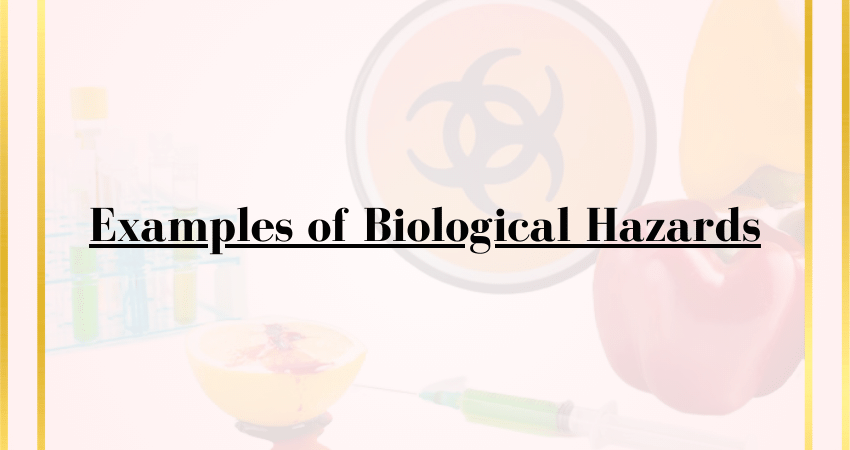Biological hazards pose risks to human health and safety in various settings, from the workplace to the kitchen. In this article, we’ll explore examples of biological hazards in different contexts, shedding light on the potential risks they pose.
Biological Hazards in Food
1. Salmonella in Uncooked Poultry
One common biological hazard in food is Salmonella, often found in raw poultry. Consumption of undercooked poultry can lead to food poisoning and severe gastrointestinal distress.
2. Listeria in Deli Meats and Soft Cheeses
Listeria monocytogenes can contaminate deli meats and soft cheeses. Ingesting this bacterium can cause Listeriosis, a severe illness, especially in pregnant women, the elderly, and those with weakened immune systems.
3. E. Coli in Raw Vegetables
Raw vegetables like spinach and lettuce can carry E. coli bacteria. When not thoroughly washed, these vegetables can transmit E. coli to consumers, resulting in digestive problems and, in severe cases, kidney damage.
4. Botulism in Canned Foods
Botulism spores can grow in improperly canned foods. If ingested, the toxin produced can lead to paralysis and respiratory failure, which can be life-threatening.
5. Mold in Stale Bread
Mold, a type of biological hazard, can grow on stale bread. Consuming bread with visible mold can lead to allergic reactions and respiratory issues.
Biological Hazards in the Workplace
1. Bloodborne Pathogens in Healthcare
Healthcare workers may be exposed to bloodborne pathogens, such as HIV or Hepatitis B, when handling blood or bodily fluids. Proper precautions and protective measures are crucial to prevent transmission.
2. Bacterial Infections in Laboratories
Laboratory workers often work with bacteria, which can pose a risk if mishandled. Examples include working with tuberculosis or antibiotic-resistant bacteria, which may lead to infections or outbreaks.
3. Mold in Construction Sites
Construction workers might encounter mold growth in damp environments. Inhaling mold spores can lead to respiratory issues, allergies, and other health concerns.
4. Animal-Borne Diseases in Agriculture
Farmers and agricultural workers can be exposed to animal-borne diseases, like brucellosis or Q fever when handling livestock. These diseases can lead to flu-like symptoms and long-term health issues.
5. Biological Hazards in Waste Management
Workers involved in waste management, including sanitation and sewage, may face exposure to biological hazards present in waste materials, leading to infections or diseases.
Biological Hazards in Food Safety
1. Cross-Contamination
Cross-contamination, such as using the same cutting board for raw meat and vegetables, can lead to the spread of bacteria, causing foodborne illnesses.
2. Improper Food Storage
Keeping perishable foods at incorrect temperatures can encourage the growth of pathogens, making them unsafe to consume.
3. Improper Hand Hygiene
Inadequate handwashing by food handlers can introduce harmful microorganisms into food, causing contamination.
4. Inadequate Cooking Temperatures
Not cooking food to the required internal temperature can leave harmful bacteria intact, posing a risk to consumers.
5. Unsanitary Food Preparation Areas
Unclean kitchen spaces, equipment, and utensils can harbor harmful microorganisms that may transfer to the food being prepared.
Biological Hazards in the Food Industry
1. Foodborne Pathogens in Processing Plants
Food processing plants may have issues with foodborne pathogens like Listeria or E. coli, which, if not properly managed, can contaminate food products.
2. Allergen Cross-Contamination
In food manufacturing, allergen cross-contamination can occur when different food products share production equipment, potentially causing allergic reactions in consumers.
3. Pesticide Residues in Agriculture
In the food industry, pesticide residues on crops can pose health risks to workers and consumers when not managed according to safety regulations.
Biological Hazards in the Laboratory
1. Handling Infectious Specimens
Laboratories often deal with infectious specimens. Mishandling pathogens like the H1N1 virus or tuberculosis can result in laboratory-acquired infections.
2. Biohazardous Waste Disposal
Improper disposal of biohazardous waste materials, such as needles or biological samples, can lead to health risks for laboratory workers and the general public.
Biological Hazards in the Kitchen
1. Uncooked Meats
In home kitchens, uncooked meats like chicken and beef can carry harmful bacteria, including Salmonella and E. coli, which can lead to foodborne illnesses.
2. Cross-Contamination in Home Cooking
Similar to food safety in the food industry, cross-contamination in home kitchens can occur when preparing food, potentially spreading bacteria to surfaces and other foods.
Biological Hazards in Healthcare
1. Infectious Diseases in Hospitals
Healthcare settings are prone to infectious diseases, including MRSA (Methicillin-resistant Staphylococcus aureus) and Clostridium difficile (C. difficile), which can spread in hospital environments.
2. Needlestick Injuries
Healthcare workers may face the risk of needlestick injuries, potentially exposing them to bloodborne pathogens from patients.
Biological hazards can be found in various settings, and recognizing them is essential for prevention. Proper education, training, and adherence to safety measures can mitigate the risks associated with these hazards.
Stay informed and take the necessary precautions to protect yourself and those around you in different environments. By understanding and addressing these examples of biological hazards, you can promote a safer and healthier lifestyle.

